Modeling and Assessment of Temperature and Thermal Stress Field of Asphalt Pavement on the Tibetan Plateau
Abstract
1. Introduction
2. Climatic Characteristics of QTP
2.1. Temperature
2.2. Solar Radiation
3. Methodology
3.1. Theoretical Equations for Temperature Fields
3.1.1. Differential Equations of Heat Conduction
3.1.2. Boundary Condition
- (1)
- Solar radiation
- (2)
- The change in air temperature
- (3)
- Effective radiation of the pavement
3.1.3. Solution Equation of Pavement Temperature Field
3.2. Basic Assumption
- (1)
- The pavement surface, subgrade, bedding layer, and soil base are considered homogeneous, isotropic, and elastic materials.
- (2)
- The layers of the pavement structure are tightly connected to each other and the stresses, displacement, and heat fluxes vary continuously among the layers.
- (3)
- The inhomogeneity of the lateral distribution of the pavement temperature field is neglected.
- (4)
- The transfer of heat flow is assumed to be one-dimensional conduction perpendicular to the pavement.
- (5)
- The parameters are considered not to vary with temperature, except for the relevant parameters mentioned in the paper.
- (6)
- Due to the asphalt mixture’s inhomogeneity and discontinuities between layers could have an effect on the localized calculation results of the temperature field of asphalt pavement, but it has little effect on the overall calculation results. If further accurate local temperature field calculations are desired, a 3D temperature field model that takes into account the inhomogeneities and discontinuities can be built. The calculation accuracy of the model used in this paper has met the needs of the study.
3.3. Structure and Parameters of the Pavement
3.4. Initial Temperature Field of Asphalt Pavement
3.5. Determination of Cooling Range
3.6. Temperature Field Model
3.7. Thermal Stress Model
4. Result and Discussion
4.1. Verification of Numerical Modeling
4.2. Variation of the Heat Flow Vector
4.3. Variation of Pavement Temperature
4.4. Variation of Temperature Gradient
4.5. Analysis of Thermal Stress in One Day
4.6. Analysis of Thermal Stress in Cold Wave
4.7. Parameter Sensitivity Analysis
4.7.1. Orthogonal Experimental Design
4.7.2. Extremum Difference Analysis
4.7.3. Analysis of Variance
5. Summary and Conclusions
- (1)
- There is a significant contribution of temperature and solar radiation to the pavement temperature field, and this effect decreases with depth. The portion below the subgrade is almost unaffected. This is because it takes time for heat to conduct, and the deeper the depth, the longer it takes for its heat to conduct, making it insensitive to changes in the external environment. The temperature gradient under the effects of solar radiation reaches a maximum of 152.6 °C/m.
- (2)
- The pavement temperature field has a substantial bearing on the pavement thermal stress, and the trend of the pavement thermal stress is heightened to resemble the temperature field. When the pavement temperature reaches its minimum, the tensile stress in the pavement reaches its maximum.
- (3)
- The cooling amplitude has a dramatic effect on the thermal stress of the pavement when cold snaps hit. For every 5 °C increase in cooling amplitude, the thermal stress rises by more than 50%. This is because the greater the cooling, the greater the temperature gradient of the pavement, making the temperature-induced strains at different depths of the pavement vary widely, ultimately resulting in higher temperature stresses.
- (4)
- The surface temperature shrinkage coefficient and surface modulus have the strongest impact on the thermal stress of the pavement. Where the change in the temperature shrinkage coefficient directly affects the temperature-induced strain, and the surface modulus affects the thermal stress due to strain. The thermal stress can be reduced by more than 0.4 MPa when the surface temperature shrinkage coefficient is reduced by 5 × 10−6/°C or the surface modulus is reduced by 1000 Mpa. In the design and construction of pavement in large temperature difference areas, the surface temperature shrinkage coefficient and surface modulus should be suitably lowered to diminish the thermal stress of the pavement.
- (5)
- It is recommended to employ a structure with a surface modulus of 3500 Mpa, a surface thickness of 18 cm, a surface temperature shrinkage coefficient of 1.5 × 10−5/°C, a base modulus of 2100 Mpa, and a base thickness of 20 cm as the anti-cracking structure of asphalt pavement.
Author Contributions
Funding
Data Availability Statement
Acknowledgments
Conflicts of Interest
References
- Lou, P.; Wu, T.; Yang, S.; Wu, X.; Chen, J.; Zhu, X.; Chen, J.; Lin, X.; Li, R.; Shang, C.; et al. Deep learning reveals rapid vegetation greening in changing climate from 1988 to 2018 on the Qinghai-Tibet Plateau. Ecol. Indic. 2023, 148, 110020. [Google Scholar] [CrossRef]
- Li, Z.; Wang, S. Transferring heat accumulated by asphalt pavement from inside to outside through carbon fibers. Constr. Build. Mater. 2023, 383, 131314. [Google Scholar] [CrossRef]
- Jiang, G.; Zhao, H.; Liu, Y.; Wu, Q.; Gao, S. Discrepancies of permafrost variations under thermal impacts from highway and railway on the Qinghai-Tibet Plateau. Cold Reg. Sci. Technol. 2023, 208, 103784. [Google Scholar] [CrossRef]
- Sha, A.; Ma, B.; Wang, H.; Hu, L.; Mao, X.; Zhi, X.; Chen, H.; Liu, Y.; Ma, F.; Liu, Z.; et al. Highway constructions on the Qinghai-Tibet Plateau: Challenge, research and practice. J. Road Eng. 2022, 2, 1–60. [Google Scholar] [CrossRef]
- Șerban, R.-D.; Bertoldi, G.; Jin, H.; Șerban, M.; Luo, D.; Li, X. Spatial variations in ground surface temperature at various scales on the northeastern Qinghai-Tibet Plateau, China. Catena 2023, 222, 106811. [Google Scholar] [CrossRef]
- Pszczoła, M.; Szydłowski, C. Influence of Bitumen Type and Asphalt Mixture Composition on Low-Temperature Strength Properties According to Various Test Methods. Materials 2018, 11, 2118. [Google Scholar] [CrossRef] [PubMed]
- Judycki, J. A new viscoelastic method of calculation of low-temperature thermal stresses in asphalt layers of pavements. Int. J. Pavement Eng. 2018, 19, 24–36. [Google Scholar] [CrossRef]
- Cui, T.; Zhang, T.; Wang, J.; Chen, J.; Wang, W.; Wang, H.; Wang, H.; Yang, D. Optimization and regulation of pavement concrete properties in plateau environment with large daily temperature difference: From mixture design to field application. Constr. Build. Mater. 2023, 378, 131167. [Google Scholar] [CrossRef]
- Tang, J.; Fu, Y.; Ma, T.; Zheng, B.; Zhang, Y.; Huang, X. Investigation on low-temperature cracking characteristics of asphalt mixtures: A virtual thermal stress restrained specimen test approach. Constr. Build. Mater. 2022, 347, 128541. [Google Scholar] [CrossRef]
- Adam, Q.F.; Levenberg, E.; Ingeman-Nielsen, T.; Skar, A. Modeling the use of an electrical heating system to actively protect asphalt pavements against low-temperature cracking. Cold Reg. Sci. Technol. 2023, 205, 103681. [Google Scholar] [CrossRef]
- Zhang, J.; Cao, D.; Zhang, J. Three-dimensional modelling and analysis of fracture characteristics of overlaid asphalt pavement with initial crack under temperature and traffic loading. Constr. Build. Mater. 2023, 367, 130306. [Google Scholar] [CrossRef]
- Zeiada, W.; Hamad, K.; Omar, M.; Underwood, B.; Khalil, M.; Karzad, A. Investigation and modelling of asphalt pavement performance in cold regions. Int. J. Pavement Eng. 2019, 20, 986–997. [Google Scholar] [CrossRef]
- Rys, D.; Judycki, J.; Pszczola, M.; Jaczewski, M.; Mejlun, L. Comparison of low-temperature cracks intensity on pavements with high modulus asphalt concrete and conventional asphalt concrete bases. Constr. Build. Mater. 2017, 147, 478–487. [Google Scholar] [CrossRef]
- Guo, Q.; Wang, H.; Gao, Y.; Jiao, Y.; Liu, F.; Dong, Z. Investigation of the low-temperature properties and cracking resistance of fiber-reinforced asphalt concrete using the DIC technique. Eng. Fract. Mech. 2020, 229, 106951. [Google Scholar] [CrossRef]
- Fu, Q.; Chen, X.; Qiu, X. Spatial distribution characterization of the Temperature-induced gradient viscoelasticity inside asphalt pavement. Constr. Build. Mater. 2022, 346, 128454. [Google Scholar] [CrossRef]
- Ma, B.; Zhou, X.; Liu, J.; You, Z.; Wei, K.; Huang, X. Determination of Specific Heat Capacity on Composite Shape-Stabilized Phase Change Materials and Asphalt Mixtures by Heat Exchange System. Materials 2016, 9, 389. [Google Scholar] [CrossRef] [PubMed]
- Han, D.; Liu, G.; Zhao, Y.; Pan, Y.; Yang, T. Research on thermal properties and heat transfer of asphalt mixture based on 3D random reconstruction technique. Constr. Build. Mater. 2021, 270, 121393. [Google Scholar] [CrossRef]
- Shamsaei, M.; Carter, A.; Vaillancourt, M. A review on the heat transfer in asphalt pavements and urban heat island mitigation methods. Constr. Build. Mater. 2022, 359, 129350. [Google Scholar] [CrossRef]
- Barber, E.S. Calculation of Maximum Pavement Temperatures from Weather Reports. Highw. Res. Board Bull. 1957, 168, 00237705. [Google Scholar]
- Christison, J.T.; Anderson, K.O. The Response of asphalt pavements to low temperature climatic environments. In Proceedings of the Third International Conference on the Structural Design of Asphalt Pavements, London, UK, 11–15 September 1972. [Google Scholar]
- Roque, R.; Buth, B.E. Materials characterization and response of flexible pavements at low temperatures (with discussion). In Association of Asphalt Paving Technologists Proceedings; AAPT: Lino Lakes, MN, USA, 1987. [Google Scholar]
- Lytton, R.L.; Pufahl, D.E.; Michalak, C.H.; Liang, H.S.; Dempsey, B.J. An Integrated Model of the Climatic Effects on Pavements. Final Report. 1993. Available online: https://api.semanticscholar.org/CorpusID:126682412.1993.11.1 (accessed on 17 June 2024).
- Zhao, X.; Shen, A.; Ma, B. Temperature response of asphalt pavement to low temperatures and large temperature differences. Int. J. Pavement Eng. 2020, 21, 49–62. [Google Scholar] [CrossRef]
- Chen, J.; Wang, H.; Zhu, H. Analytical approach for evaluating temperature field of thermal modified asphalt pavement and urban heat island effect. Appl. Therm. Eng. 2017, 113, 739–748. [Google Scholar] [CrossRef]
- Si, W.; Ma, B.; Zhou, X.Y.; Ren, J.P.; Tian, Y.X.; Li, Y. Temperature responses of asphalt mixture physical and finite element models constructed with phase change material. Constr. Build. Mater. 2018, 178, 529–541. [Google Scholar] [CrossRef]
- Tran, T.T.; Nguyen, H.H.; Pham, P.N.; Nguyen, T.; Nguyen, P.Q.; Huynh, H.N. Temperature-related thermal properties of paving materials: Experimental analysis and effect on thermal distribution in semi-rigid pavement. Road Mater. Pavement Des. 2023, 24, 2759–2779. [Google Scholar] [CrossRef]
- Hall, M.R.; Dehdezi, P.K.; Dawson, A.R.; Grenfell, J.; Isola, R. Influence of the thermophysical properties of pavement materials on the evolution of temperature depth profiles in different climatic regions. J. Mater. Civ. Eng. 2012, 24, 32–47. [Google Scholar] [CrossRef]
- Kang, X.; Zheng, Y.; Zhang, H. Finite element analysis of temperature field and stress field of asphalt pavement based on continuous temperature change. Highway 2020, 65, 191–195. [Google Scholar]
- Middel, A.; Turner, V.; Schneider, F.; Zhang, Y.; Stiller, M. Solar reflective pavements—A policy panacea to heat mitigation? Environ. Res. Lett. 2020, 15, 064016. [Google Scholar] [CrossRef]
- Sun, Y.; Du, C.; Gong, H.; Li, Y.; Chen, J. Effect of temperature field on damage initiation in asphalt pavement: A microstructure-based multiscale finite element method. Mech. Mater. 2020, 144, 103367. [Google Scholar] [CrossRef]
- Llopis-Castelló, D.; García-Segura, T.; Montalbán-Domingo, L.; Sanz-Benlloch, A.; Pellicer, E. Influence of Pavement Structure, Traffic, and Weather on Urban Flexible Pavement Deterioration. Sustainability 2020, 12, 9717. [Google Scholar] [CrossRef]
- Hu, J.; Ma, T.; Zhu, Y.; Huang, X.; Xu, J.; Chen, L. High-viscosity modified asphalt mixtures for double-layer porous asphalt pavement: Design optimization and evaluation metrics. Constr. Build. Mater. 2021, 271, 121893. [Google Scholar] [CrossRef]
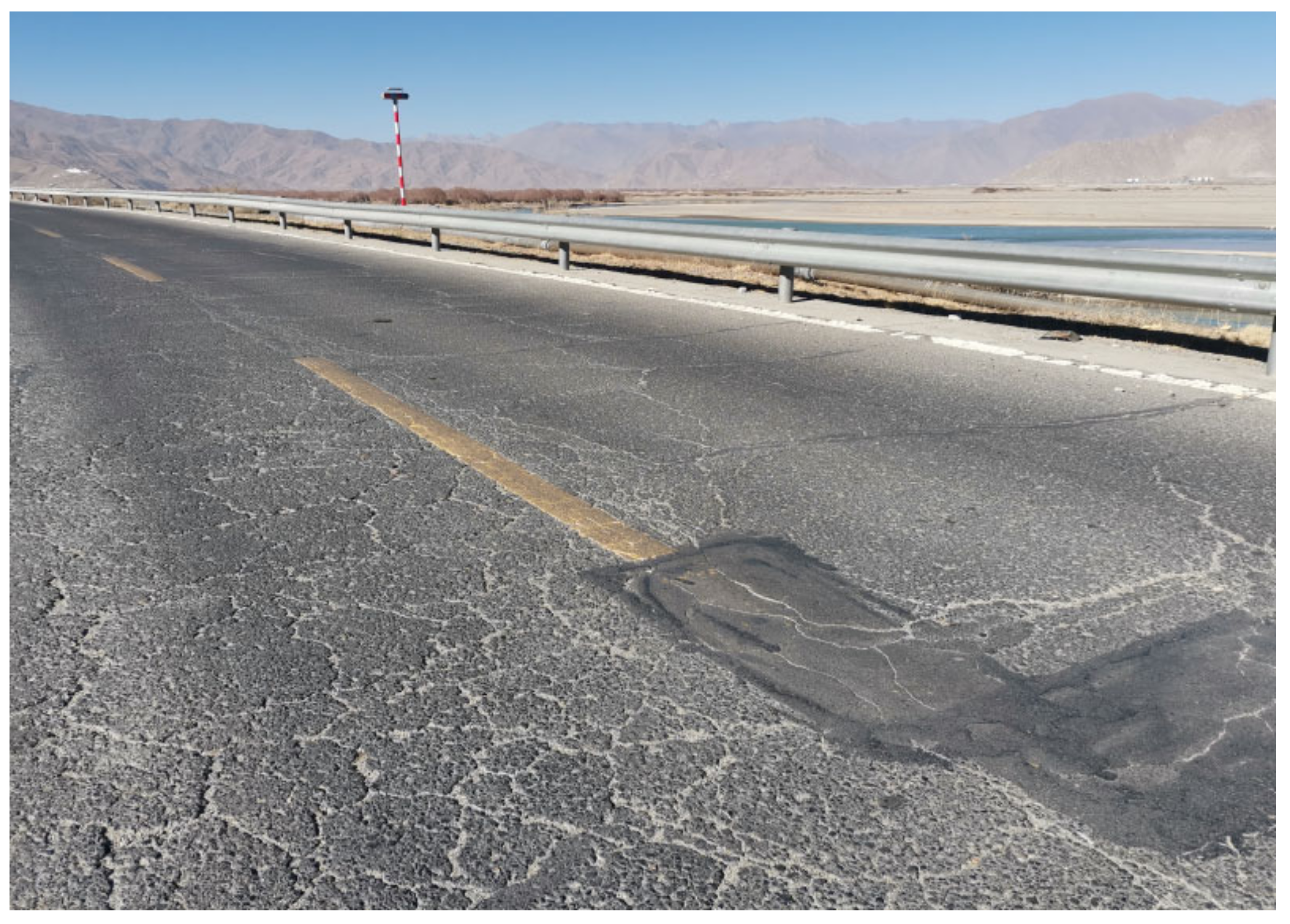
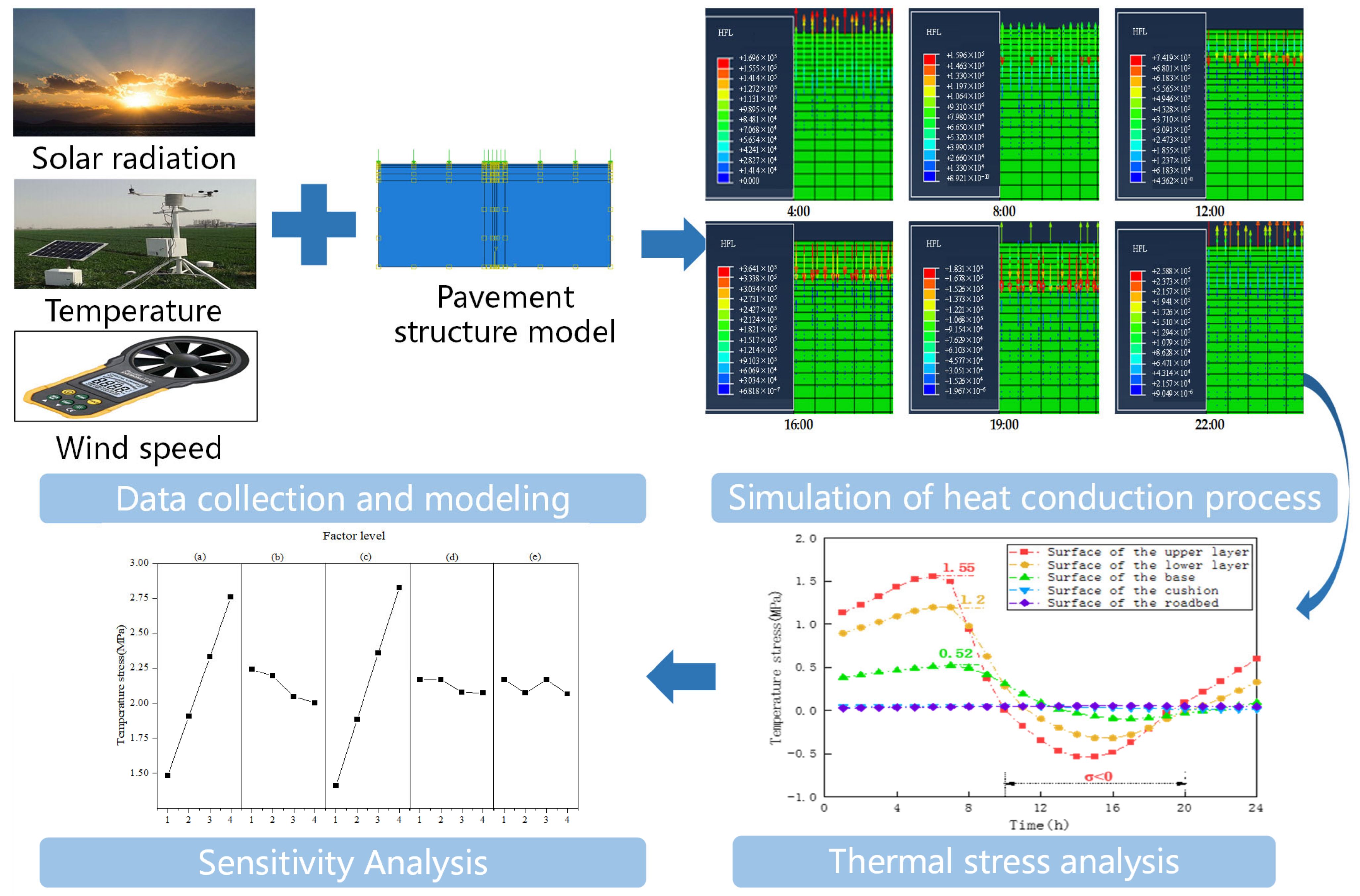



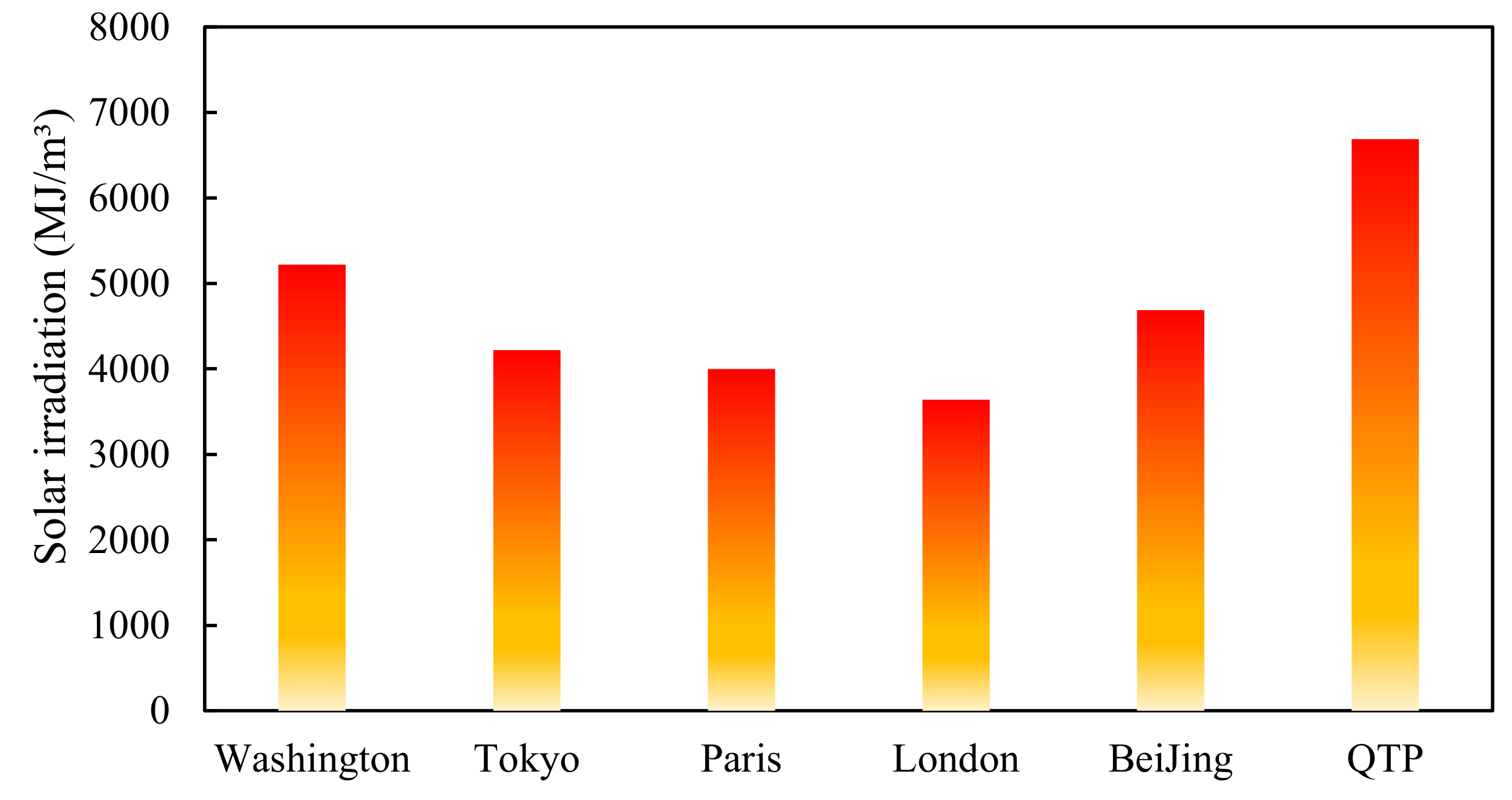
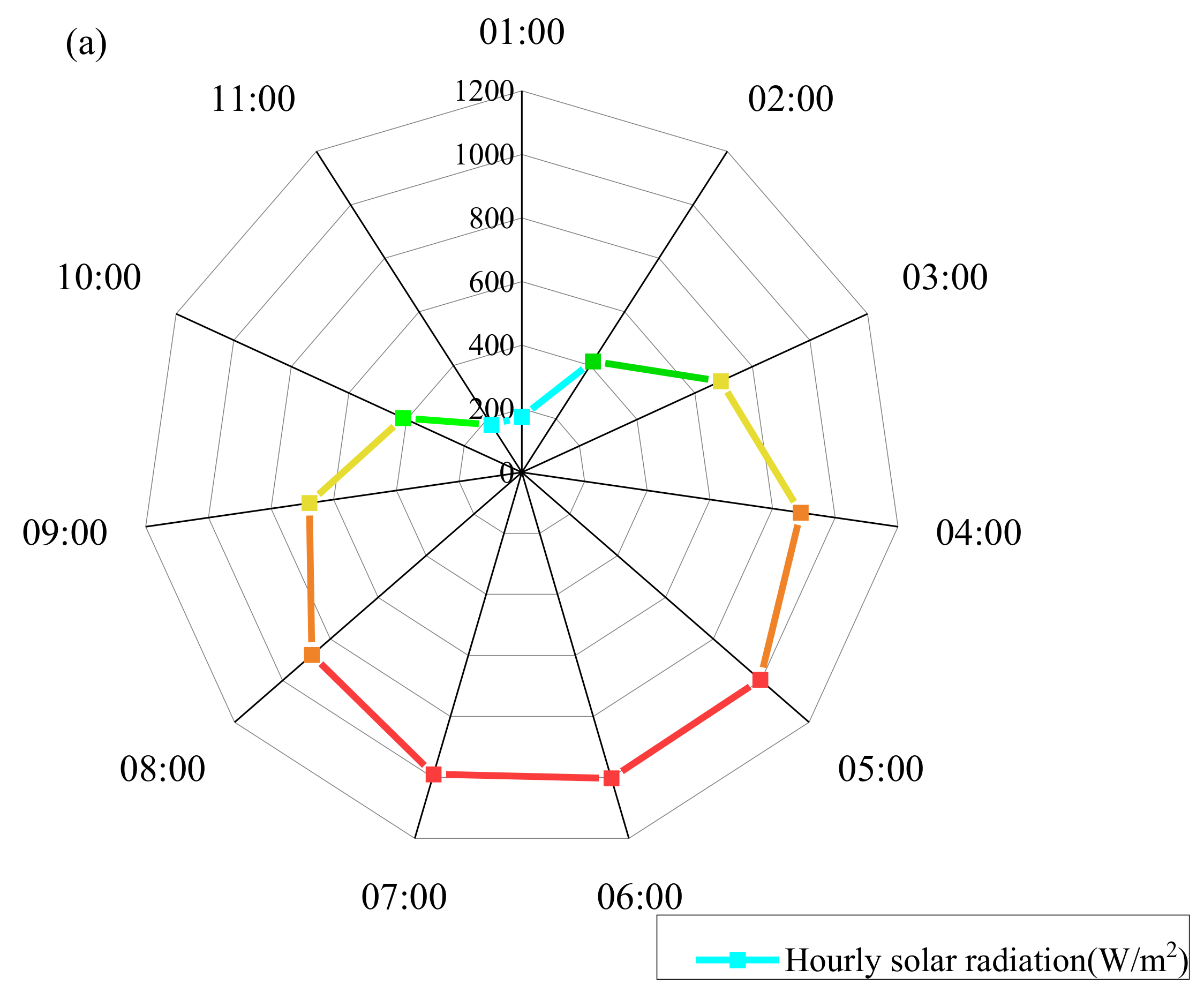
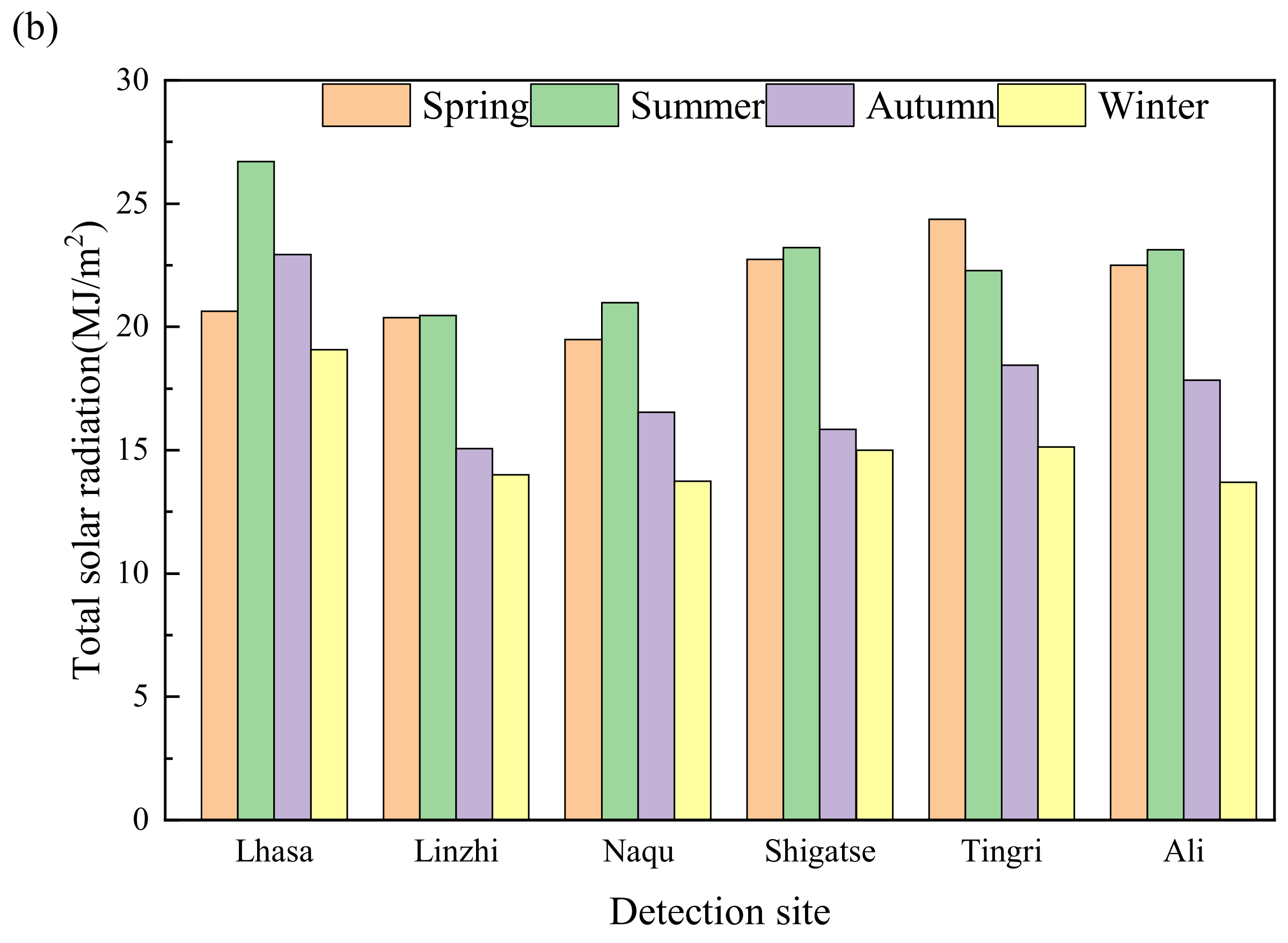

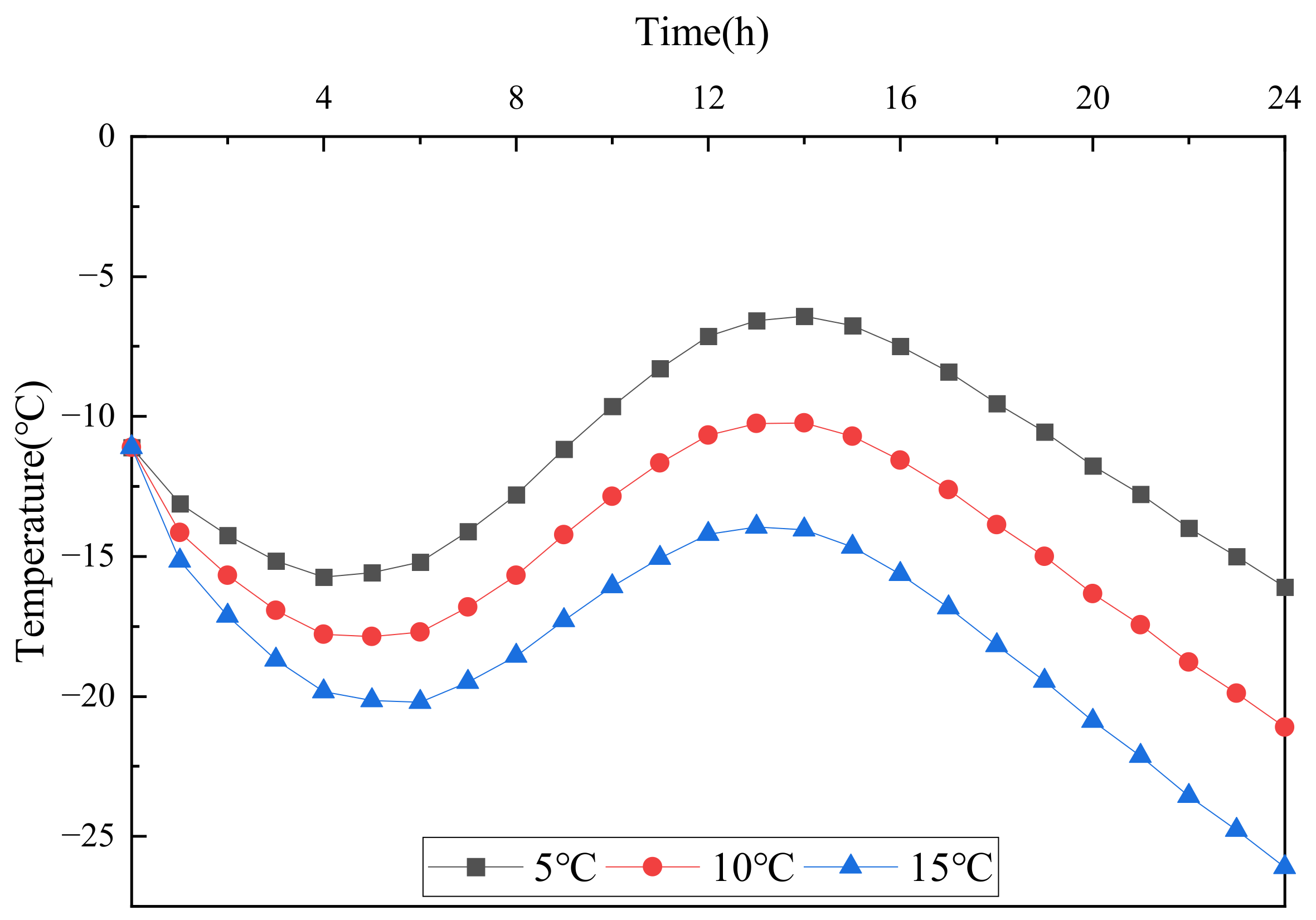
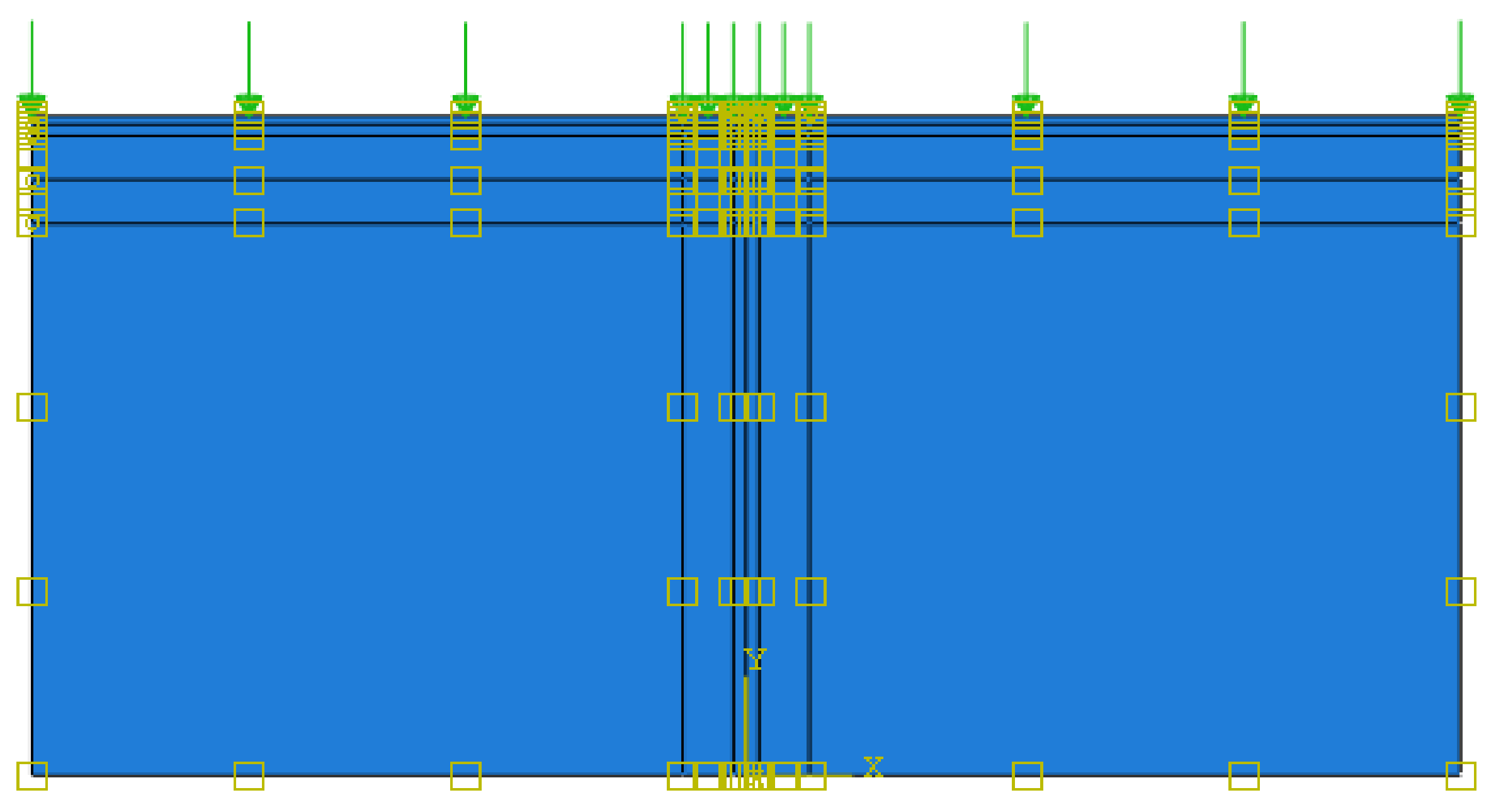
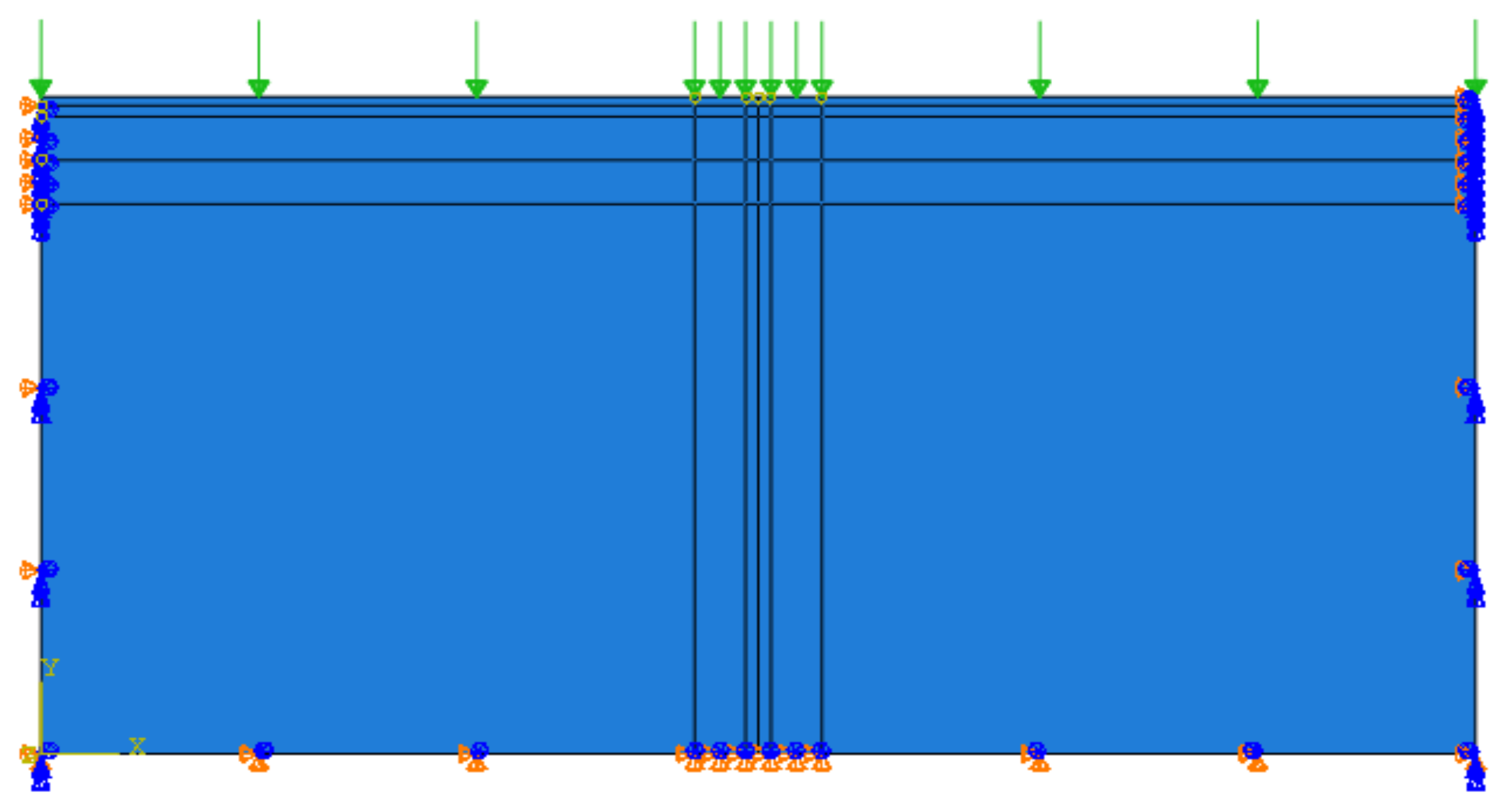

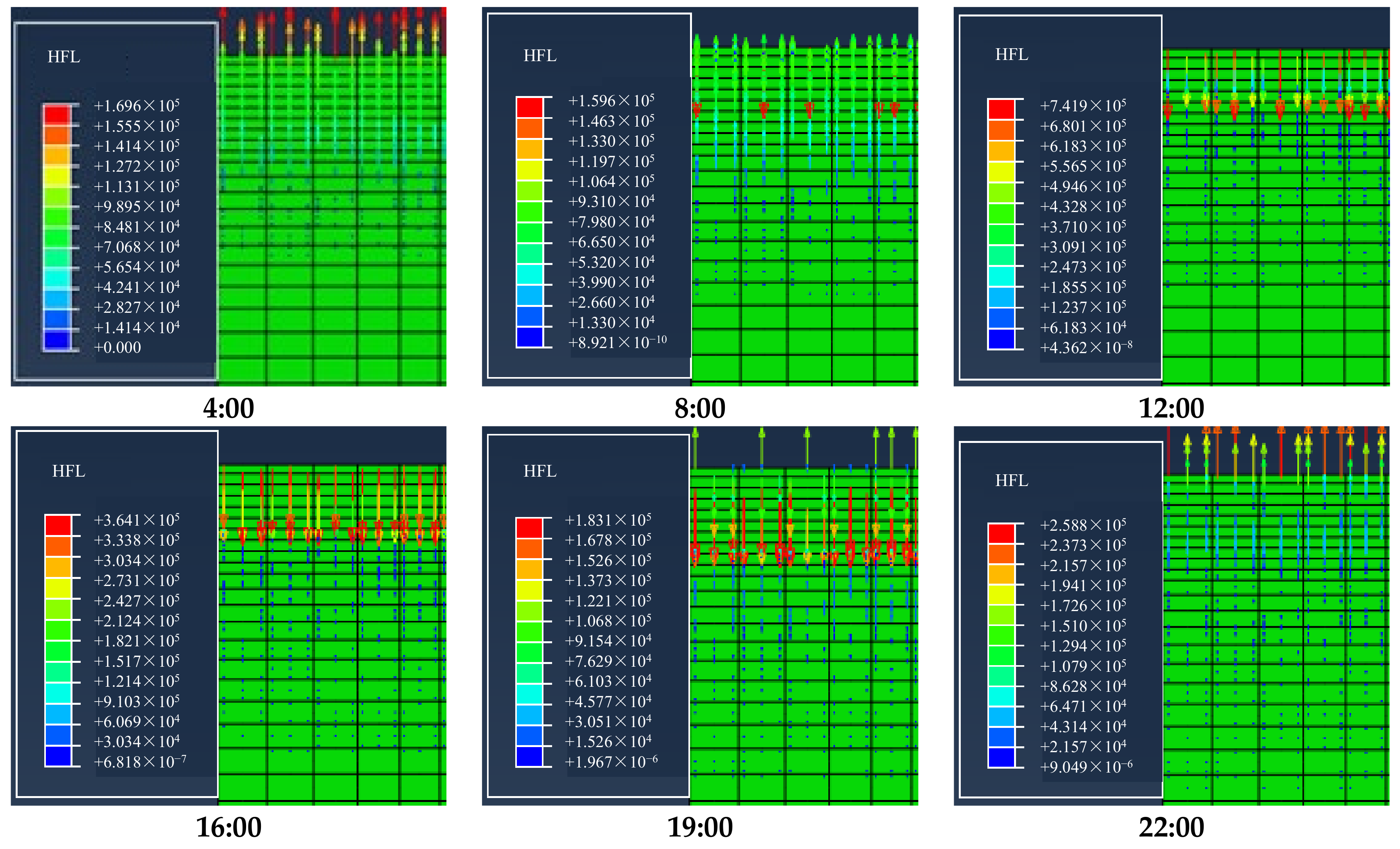
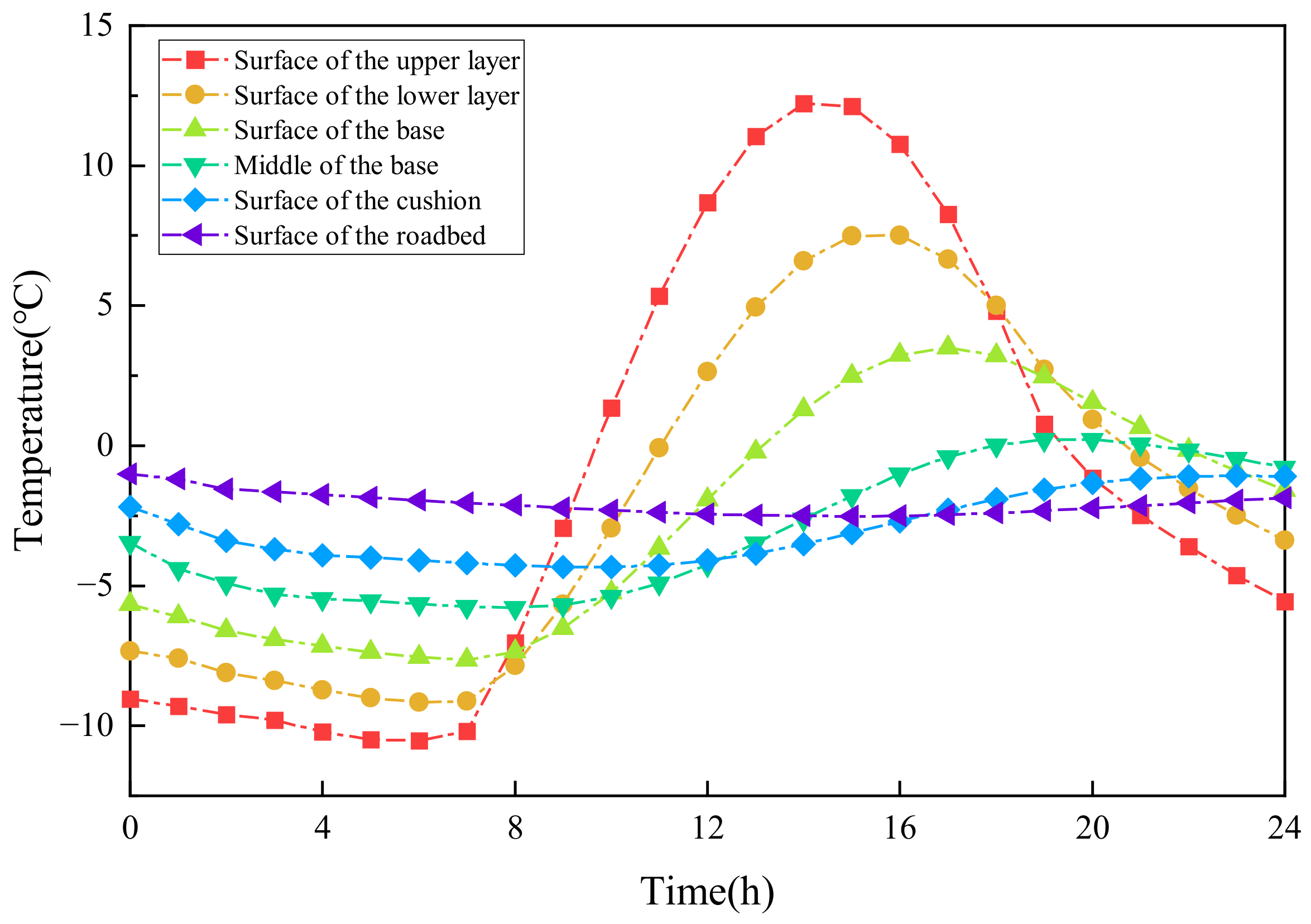
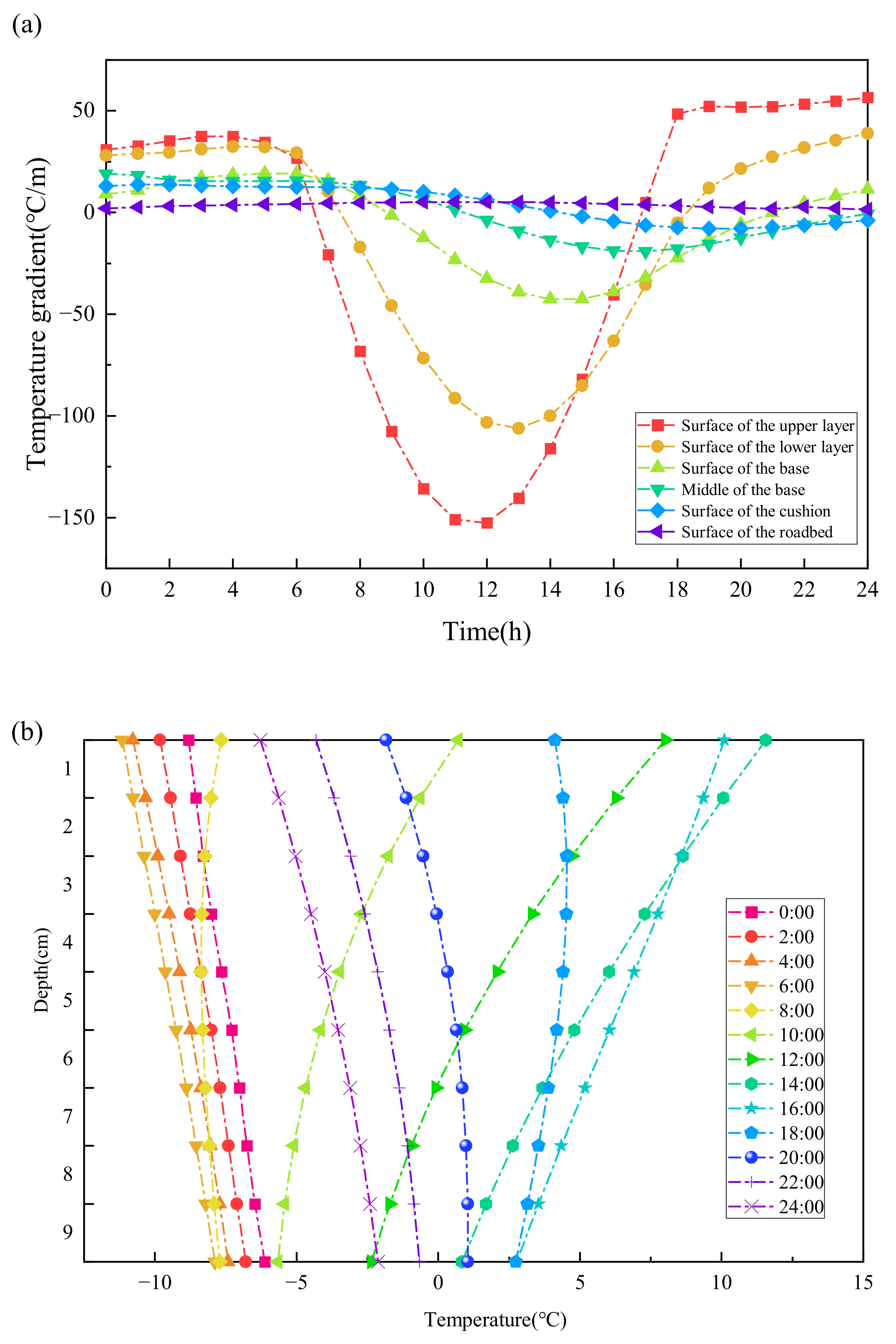

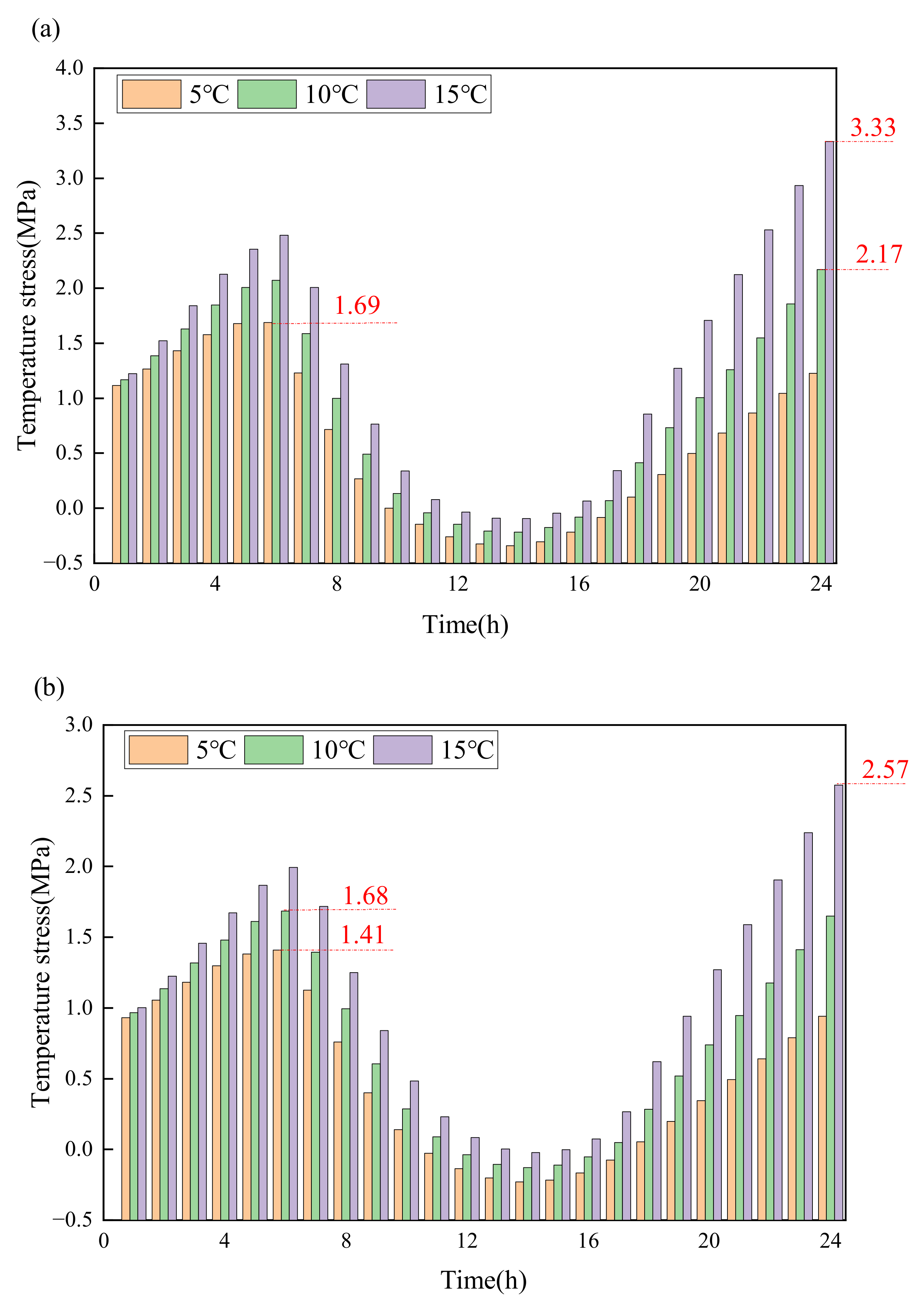


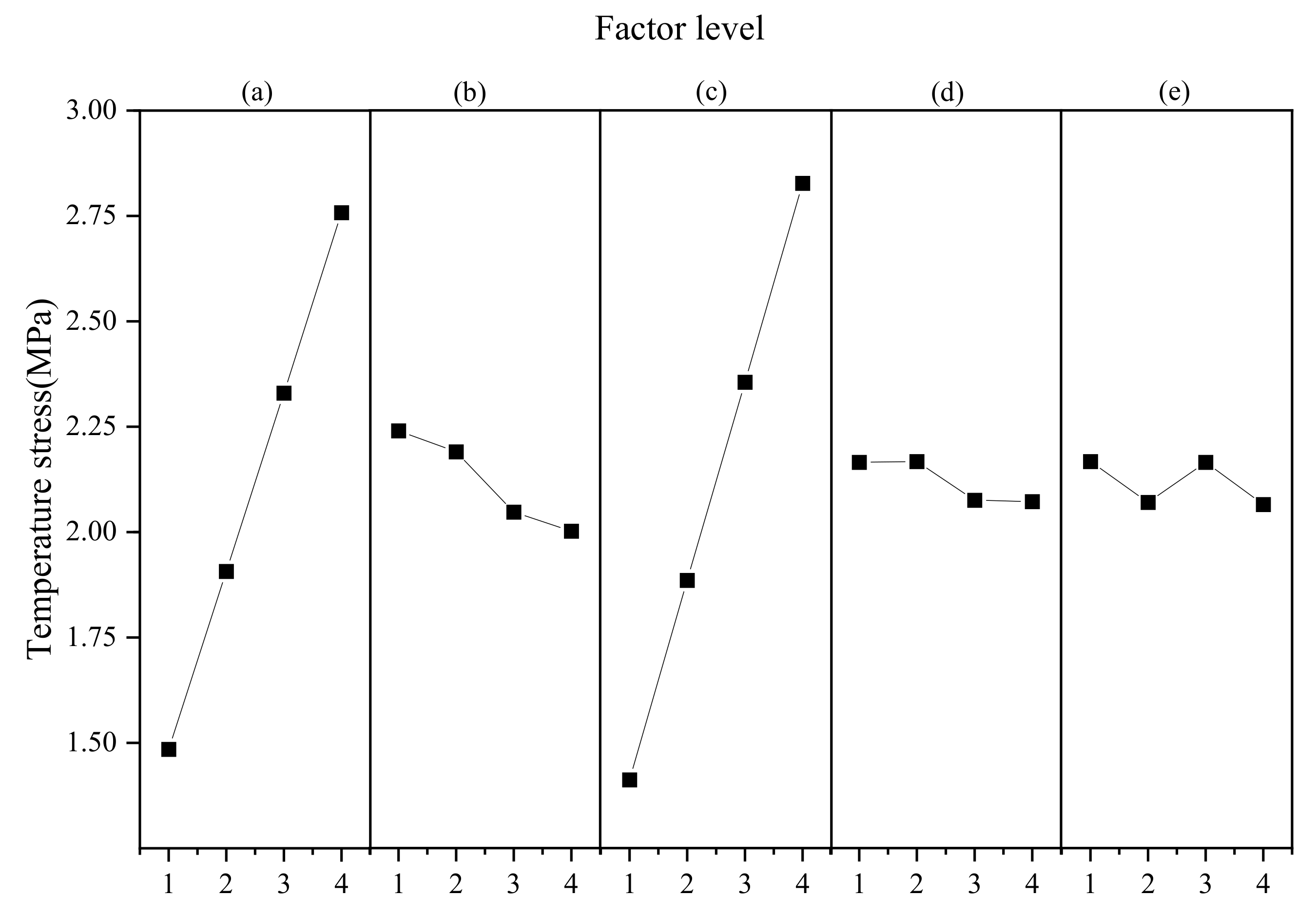
| Region | Longitude | Dimensional | Elevation (m) |
|---|---|---|---|
| Dangxiong | 90°45′–91°31′ E | 29°31′–31°04′ N | 4300 |
| Jiangzi | 89°06′–90°12′ E | 28°30′–29°18′ N | 4000 |
| Naqu | 83°55′–95°05′ E | 29°55′–36°30′ N | 4450 |
| Zedang | 91°48′ E | 29°14′ N | 3580 |
| Linzhi | 92°09′–98°47′ E | 26°52′–30°40′ N | 3100 |
| Structural Layer | Above Layer AC-13 | Lower Layer AC-20 | Base Cement Stabilized Macadam | Cushion Graded Gravel | Soil |
|---|---|---|---|---|---|
| Thickness (cm) | 4 | 5 | 20 | 20 | |
| Thermal conductivity | 4200 | 4000 | 5400 | 5200 | 5400 |
| Density | 2400 | 2500 | 2100 | 2000 | 1800 |
| Specific heat | 950 | 900 | 900 | 950 | 1000 |
| Solar radiation absorptivity | 0.9 | ||||
| Road surface reflectance | 0.81 | ||||
| Absolute zero (°C) | −273 | ||||
| Stefan–Boltzmann constant | 2.041 × 10−4 | ||||
| Structural Layer | Material Type | Temperature (°C) | Elastic Modulus (MPa) | Poisson’s Ratio |
|---|---|---|---|---|
| Above layer | AC-13 | 10 | 900 | 0.3 |
| 0 | 1400 | 0.3 | ||
| −10 | 4500 | 0.25 | ||
| −20 | 9000 | 0.25 | ||
| −30 | 14,000 | 0.25 | ||
| Lower layer | AC-20 | 10 | 1000 | 0.3 |
| 0 | 1200 | 0.3 | ||
| −10 | 4200 | 0.25 |
| Material Type | Temperature Shrinkage Coefficient at Different Temperatures (×10−5) | ||||
|---|---|---|---|---|---|
| 0 °C | −10 °C | −20 °C | −30 °C | ||
| Asphalt mixture | AC-13 | 2.5 | 2.2 | 1.9 | 1.6 |
| AC-20 | 2.5 | 2.2 | 1.9 | 1.6 | |
| Cement stabilized macadam | 0.98 | ||||
| Graded gravel | 0.5 | ||||
| Soil | 50 | ||||
| Time (h) | 0 | 1 | 2 | 3 | 4 | 5 | 6 | 7 | 8 | 9 | 10 | 11 |
| Temperature (°C) | −9.1 | −10.1 | −11.1 | −12.1 | −12.9 | −13.5 | −13.7 | −13.4 | −12.7 | −11.5 | −9.9 | −8.2 |
| Time (h) | 12 | 13 | 14 | 15 | 16 | 17 | 18 | 19 | 20 | 21 | 22 | 23 |
| Temperature (°C) | −6.4 | −4.8 | −3.6 | −2.9 | −2.6 | −2.8 | −3.4 | −4.2 | −5.2 | −6.2 | −7.2 | −8.2 |
| Factor/Level | Surface Modulus (MPa) | Surface Thickness (cm) | Surface Temperature Shrinkage Coefficient (10−5/°C) | Base Modulus (MPa) |
|---|---|---|---|---|
| 1 | 3500 | 9 | 1.5 | 1200 |
| 2 | 4500 | 12 | 2 | 1500 |
| 3 | 5500 | 15 | 2.5 | 1800 |
| 4 | 6500 | 18 | 3 | 2100 |
| Test Serial Number | Surface Modulus (MPa) | Surface Thickness (cm) | Surface Temperature Shrinkage Coefficient (10−5/°C) | Base Modulus (MPa) | Blank Column | Thermal Stress (MPa) |
|---|---|---|---|---|---|---|
| 1 | 1 (3500) | 1 (9) | 1 (1.5) | 1 (1200) | 1 | 0.99 |
| 2 | 1 | 2 (12) | 2 (2.0) | 2 (1500) | 2 | 1.32 |
| 3 | 1 | 3 (15) | 3 (2.5) | 3 (1800) | 3 | 1.65 |
| 4 | 1 | 4 (18) | 4 (3.0) | 4 (2100) | 4 | 1.98 |
| 5 | 2 (4500) | 1 | 2 | 3 | 4 | 1.70 |
| 6 | 2 | 2 | 1 | 4 | 3 | 1.27 |
| 7 | 2 | 3 | 4 | 1 | 2 | 2.54 |
| 8 | 2 | 4 | 3 | 2 | 1 | 2.12 |
| 9 | 3 (5500) | 1 | 3 | 4 | 2 | 2.59 |
| 10 | 3 | 2 | 4 | 3 | 1 | 3.11 |
| 11 | 3 | 3 | 1 | 2 | 4 | 1.55 |
| 12 | 3 | 4 | 2 | 1 | 3 | 2.07 |
| 13 | 4 (6500) | 1 | 4 | 2 | 3 | 3.68 |
| 14 | 4 | 2 | 3 | 1 | 4 | 3.06 |
| 15 | 4 | 3 | 2 | 4 | 1 | 2.45 |
| 16 | 4 | 4 | 1 | 3 | 2 | 1.84 |
| Level | Surface Modulus | Surface Thickness | Surface Temperature Shrinkage Coefficient | Base Modulus |
|---|---|---|---|---|
| 1 | 1.485 | 2.240 | 1.412 | 2.165 |
| 2 | 1.907 | 2.190 | 1.885 | 2.167 |
| 3 | 2.330 | 2.047 | 2.355 | 2.075 |
| 4 | 2.758 | 2.002 | 2.827 | 2.072 |
| Extreme difference | 1.273 | 0.237 | 1.415 | 0.095 |
| Surface Modulus (MPa) | Surface Thickness (cm) | Surface Temperature Shrinkage Coefficient (10−5/°C) | Base Modulus (MPa) | Base Thickness (cm) |
|---|---|---|---|---|
| 3500 | 18 | 1.5 | 2100 | 20 |
| Project | Surface Modulus | Surface Thickness | Surface Temperature Shrinkage Coefficient | Base Modulus |
|---|---|---|---|---|
| Degree of freedom (DF) | 3 | 3 | 3 | 3 |
| The sum of squares deviation from the mean (MS) | 3.596 | 0.153 | 4.446 | 0.034 |
| Mean square (SS) | 1.198 | 0.051 | 1.482 | 0.011 |
| F-valued | 3.08 | 0.08 | 4.66 | 0.02 |
| Critical value | F0.05(3,12) = 3.49; F0.1(3,12) = 2.56 | |||
| Significance | Obvious | Insignificant | Obvious | Insignificant |
Disclaimer/Publisher’s Note: The statements, opinions and data contained in all publications are solely those of the individual author(s) and contributor(s) and not of MDPI and/or the editor(s). MDPI and/or the editor(s) disclaim responsibility for any injury to people or property resulting from any ideas, methods, instructions or products referred to in the content. |
© 2024 by the authors. Licensee MDPI, Basel, Switzerland. This article is an open access article distributed under the terms and conditions of the Creative Commons Attribution (CC BY) license (https://creativecommons.org/licenses/by/4.0/).
Share and Cite
Li, B.; Xie, Y.; Bi, Y.; Zou, X.; Tian, F.; Cong, Z. Modeling and Assessment of Temperature and Thermal Stress Field of Asphalt Pavement on the Tibetan Plateau. Buildings 2024, 14, 2196. https://doi.org/10.3390/buildings14072196
Li B, Xie Y, Bi Y, Zou X, Tian F, Cong Z. Modeling and Assessment of Temperature and Thermal Stress Field of Asphalt Pavement on the Tibetan Plateau. Buildings. 2024; 14(7):2196. https://doi.org/10.3390/buildings14072196
Chicago/Turabian StyleLi, Bin, Yadong Xie, Yanqiu Bi, Xiaoling Zou, Fafu Tian, and Zhimin Cong. 2024. "Modeling and Assessment of Temperature and Thermal Stress Field of Asphalt Pavement on the Tibetan Plateau" Buildings 14, no. 7: 2196. https://doi.org/10.3390/buildings14072196
APA StyleLi, B., Xie, Y., Bi, Y., Zou, X., Tian, F., & Cong, Z. (2024). Modeling and Assessment of Temperature and Thermal Stress Field of Asphalt Pavement on the Tibetan Plateau. Buildings, 14(7), 2196. https://doi.org/10.3390/buildings14072196






